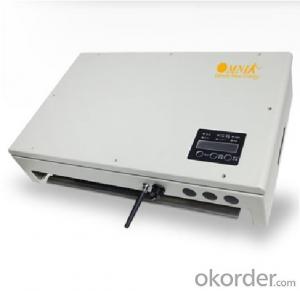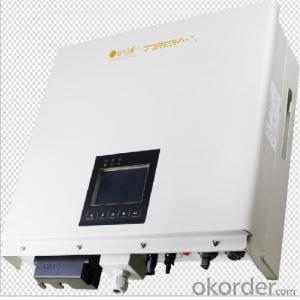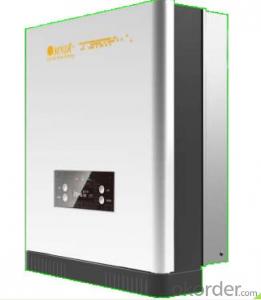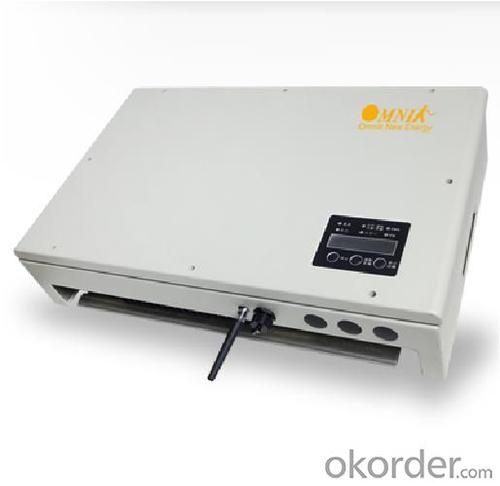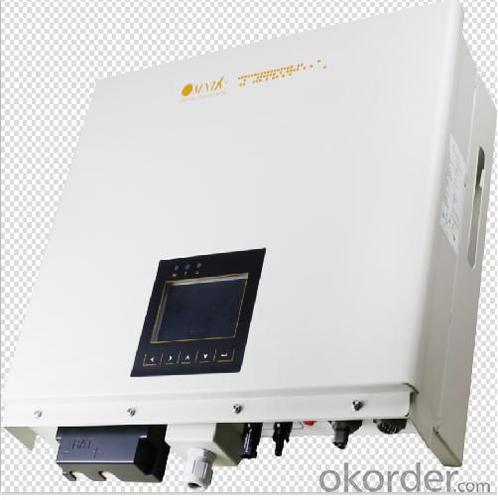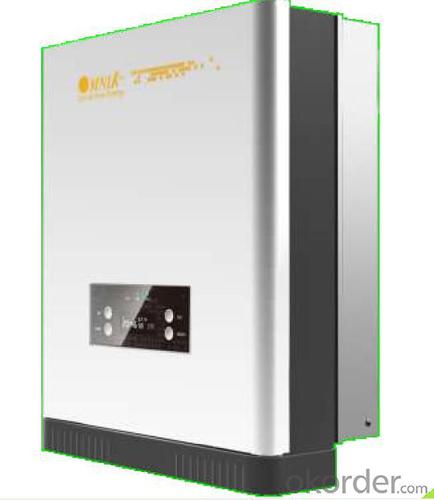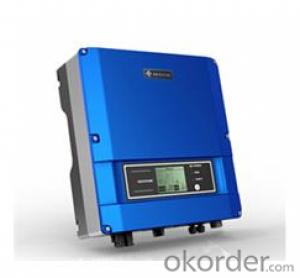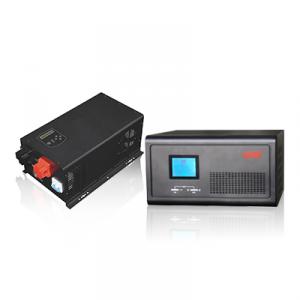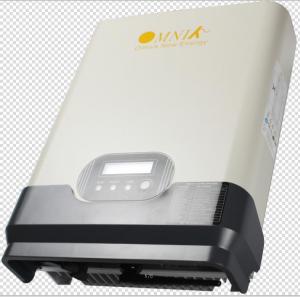Tesla Solar Inverter Omniksol-4.0k-JP
- Loading Port:
- Shanghai
- Payment Terms:
- TT OR LC
- Min Order Qty:
- 1 pc
- Supply Capability:
- 3000 pc/month
OKorder Service Pledge
OKorder Financial Service
You Might Also Like
Omnik new energy solar inverter
Omniksol-2.0k-TL Photon Efficiency up to 3kW
in the world------ Photon tested Jan. 2012.
Omniksol-4k-JP
Futures
Omniksol-4k-JP PV inverter ,featuring two MPPT tracker, maximum converstaion efficiency 96.2%,off-grid to on grid mutual switch , IP 65 Protection design, easy installation , is special designed for Janpan consumer.
1.Features
Transformer design, high frequency isolation technology with high security
High efficiency (Max.96.2%), High MPPT accuracy(>99.9%)
2 MPPT design, reach the maximum output power
Wide DC input range (95-420 Vdc),lower start voltage 65Vdc
on-grid/ off grid switch function
IP 65 design, suitable for indoor and outdoor installation
10 years warranty(10~25 years as option)
2.Technical data:
Inverter Type | Omniksol-3k-TL | Omniksol-4k-TL | Omniksol-5k-TL | |
| Input(DC) | Max.PV Input voltage[V] | 450 | ||
| Input Voltage Range(MPPT)[V] | 95-420 | |||
| Operation voltage Range[V] | 75-420 | |||
| Rating Input voltage[V] | 280 | |||
| Wake Up voltage[V] | 65 | |||
| Number of MPPT Trackers | 2 | |||
| Input Power Limitation[W] | 1600 | 2100 | 2600 | |
| Input Current Limitation[A] | 8 | 10 | 12 | |
| MPPT Efficiency | 99.90% | |||
| Efficiency | >96% | >96% | >96.2% | |
| Input Switch[A] | 8 | 10 | 12 | |
3. Omniksol-4k-JP
JET
ISO
CE
4. product outlook
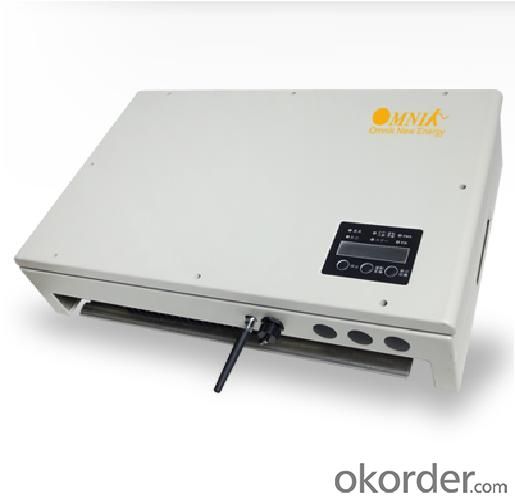
FAQ
1. How long will my inquiry get response?
Your inquiry related to our products or prices will be replied within 24 hours.
2. Can I get professional service and suggestion?
Well-trained and experienced staffs to answer all your questions in fluent English.
3. Do you accept OEM or customized design?
OEM & ODM, any your customized lightings we can help you to design and put into product.
4. What if I need specific design?
Distributorship are offered for your unique design and some our current models.
- Q: What is the impact of temperature on the performance of a solar inverter?
- The impact of temperature on the performance of a solar inverter is significant. As temperature increases, the efficiency of the inverter tends to decrease. This is because higher temperatures can lead to increased resistive losses, increased internal losses, and decreased power conversion efficiency. Additionally, overheating can cause the inverter to shut down or operate at reduced capacity to prevent damage. Therefore, it is important to consider temperature management and cooling strategies to optimize the performance and lifespan of a solar inverter.
- Q: What is the role of a power management system in a solar inverter?
- The role of a power management system in a solar inverter is to efficiently manage the flow of electricity from the solar panels to the grid or the connected devices. It ensures that the power generated by the solar panels is optimized, regulated, and synchronized with the grid's requirements. The power management system helps in maintaining the stability and reliability of the solar inverter system by monitoring, controlling, and adjusting the power flow, voltage levels, and frequency to prevent overloading or underutilization of the solar energy.
- Q: Do I need a special inverter for a battery storage system?
- Yes, a special inverter is required for a battery storage system. Unlike traditional solar inverters that convert DC power from solar panels into AC power for immediate use or for feeding back into the grid, a battery storage system inverter is designed to manage the charging and discharging of the batteries. It ensures that the stored energy is used efficiently and safely, and allows for backup power during grid outages.
- Q: How does a solar inverter handle variations in AC load demand?
- A solar inverter handles variations in AC load demand by continuously monitoring the load demand and adjusting the amount of power it delivers from the solar panels accordingly. This is achieved through advanced control algorithms that optimize the conversion of DC power generated from the solar panels into AC power that matches the load demand. The inverter maintains a stable voltage and frequency output, ensuring that the electrical devices connected to it receive a consistent and reliable power supply, even when there are fluctuations in the AC load demand.
- Q: How does a solar inverter handle sudden changes in solar irradiation?
- A solar inverter handles sudden changes in solar irradiation by constantly monitoring the incoming solar power and adjusting its output accordingly. It has built-in technology and algorithms that enable it to quickly adapt to changes in solar irradiation levels. The inverter can efficiently convert and regulate the fluctuating DC power from the solar panels into a stable AC power output, ensuring a smooth and consistent energy supply to the connected load or grid.
- Q: Can a solar inverter be used with a solar water pumping system?
- Yes, a solar inverter can be used with a solar water pumping system.
- Q: How does a solar inverter protect against short circuits?
- A solar inverter protects against short circuits by incorporating protective devices such as fuses or circuit breakers in its design. These protective devices are designed to detect high current flow caused by a short circuit and quickly interrupt the circuit, preventing any damage or overheating that could occur. Additionally, advanced solar inverters may also include built-in monitoring systems that constantly monitor the electrical parameters and shut down the inverter in case of a short circuit to ensure safety and prevent further damage.
- Q: What is the power factor correction capability of a solar inverter?
- The power factor correction capability of a solar inverter refers to its ability to correct any power factor issues in the electrical system it is connected to. A solar inverter typically aims to achieve a power factor as close to 1 as possible, which indicates a balanced and efficient use of electrical power. By actively monitoring and adjusting the power factor, a solar inverter ensures that the energy generated from the solar panels is effectively utilized and does not cause any unnecessary strain on the electrical grid.
- Q: Can a solar inverter be used with a solar-powered water desalination system?
- Yes, a solar inverter can be used with a solar-powered water desalination system. A solar inverter is responsible for converting the direct current (DC) generated by solar panels into alternating current (AC) that can be used to power various electrical devices, including a water desalination system. By connecting the solar panels to the solar inverter and then to the water desalination system, the renewable energy produced by the sun can be harnessed and utilized efficiently for the desalination process.
- Q: What is the role of a solar inverter in preventing overloading?
- The role of a solar inverter in preventing overloading is to monitor the flow of electricity from the solar panels and regulate the amount of power being generated and fed into the electrical grid. It ensures that the solar system operates within its capacity and prevents excessive power generation that could lead to overloading and potential damage to the system or the electrical grid.
Send your message to us
Tesla Solar Inverter Omniksol-4.0k-JP
- Loading Port:
- Shanghai
- Payment Terms:
- TT OR LC
- Min Order Qty:
- 1 pc
- Supply Capability:
- 3000 pc/month
OKorder Service Pledge
OKorder Financial Service
Similar products
Hot products
Hot Searches
Related keywords
